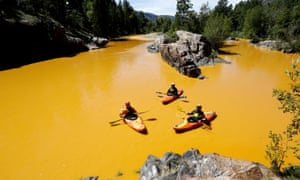
A cloud of orange-brown, toxic mine water and sludge accidentally released by the US Environmental Protection Agency is flowing down the Animas River through the hearts of towns in Colorado and New Mexico, and ultimately toward a lake in a national park.
The water, described as an “unnatural” orange color and loaded with heavy metals, was flowing through a stretch of wilderness as of Friday afternoon from Durango, Colorado toward Farmington, New Mexico. It is flowing toward the western edge of the Navajo Nation and along the Glen Canyon national recreation area in Utah.
The same area of wilderness in Utah contains well-known red rock cliffs and terraces in Utah, such as Grand Staircase-Escalante National Monument.
“It’s awful, it’s awful,” said San Juan County undersheriff Stephen Lowrance. “It’s [a] horrible, horrible accident.”
“It’s, like I said, an orange-ish brown. You wouldn’t want to drink it – that’s for sure,” said Lowrance. Lowrance and another sheriff’s deputy were at the site of the spill almost instantly when an estimated 1m gallons of mine wastewater was released into Cement Creek north of Silverton, Colorado, a tiny town with just more than 600 people.
The huge amount of water nearly flooded Cement Creek as it flowed into the Animus River, after breaking free from a shoddy dam at the Gold King Mine. EPA officials said that a blockage of loose soil and little more was holding in the bright orange wastewater at Gold King, a former gold mine, when water broke loose. An EPA official estimated that 200 gallons of wastewater per minute was still flowing out of the mine as of Friday afternoon.
The EPA was working at the property as part of a plan to remediate the superfund site and stop a longtime flow of acidic, heavy metal-laden wastewater from the nearby Red and Bonita mine, all near the abandoned Gladstone mining town. The work would have installed a bulkhead, or massive plug, at the end of the inactive mining tunnel.
The EPA’s initial tests of the wastewater and sediment in Animus found substances known to be harmful to be human health, including lead, arsenic, cadmium, copper, calcium and other heavy metals “at varying levels,” though at concentrations enough for officials to warn people away from the river. The PH of the water near the mouth of the mine was found to be 4.5,roughly that of beer. Lake water typically ranges from 6.5 to 8.5 on the PH scale.
EPA officials later told reporters that the impact on human and environmental health was not immediately clear, because toxicologists are still analyzing data from water samples.
“First off, I’d like to just say I’m sorry for what’s happened,” David Ostrander, the EPA’s head of emergency management told a standing-room-only crowd in Durango, Colorado Friday afternoon. “This is a huge tragedy, and it’s hard being on the other side of this, in terms of being the one who caused this incident.”
“We usually respond to emergencies, we don’t cause them,” said Ostrander.
The wastewater is the vestige of gold rush mining of more than 100 years ago. Though the mine still has an owner it appears to have been all but abandoned.
As the wastewater moves downstream it will enter the hearts of towns along the way – Silverton, Colorado; Durango, Colorado and Farmington, New Mexico among others. Many of the towns along the way have water-recreation-centric tourism industries. The US Parks Service raves about water recreation activities in Glen Canyon in particular.
As of Friday, people were warned away from the water for an indefinite period of time. Farmers have been asked not to use the water. Durango was using a backup water supply and asking residents to conserve. The Federal Bureau of Reclamation, which manages water supplies in the western United States, has warned strongly against any contact with the water, and is doubling the flow of water from the Navajo dam near the San Juan to try to dilute the toxic waste.

No comments:
Post a Comment